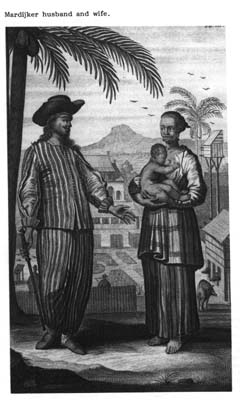|
|
||
| Cover Letter | Application (.pdf file)| Schedule (.pdf file) | Housing (.pdf file) | Resources | Course Modules | Discuss Indian Ocean | ||
| Women
and Men in the Indian Ocean World
Temporary Marriage Laura
J. Mitchell
|
 |
In some societies of the Indonesian archipelago in the fifteenth century, women were active traders in port cities. Marriage practices accommodated the economic activities of trading women as well as the trading, domestic, and sexual needs of traders, sailors, and captains who traveled with the monsoons. “In Southeast Asia, the interactions of indigenous women and male foreigners (in this case, traders more than conquerors) had a different dynamic. The societies of this region, which for centuries was a crossroads of long-distance trade and cultural exchange, and a long-standing practice of ‘temporary marriage’ between local women and foreign traders. In this practice, both partners had certain rights. The relationship did not entail loss of social status on the part of women.” (Strobel 2002, 56) These relationships offered both partners reciprocal access to trade connections. Women received goods and presents from external trading networks. Men received insight into local customs and practices, family support, and domestic arrangements. When these trading husbands left, any children stayed with the women, who was also likely to be economically advantaged by the relationship. “In such a situation, femininity involved being autonomous and economically active as a trader.” (Strobel 2002, 56)
This practice of temporary marriage differed
dramatically from European customs of the same era, yet European men—both
Dutch and Portuguese—found accommodation and economic advantage in these
relationships.
 |
issues to be raised with students: Dynamics of Indian
Ocean Trade
What are the variety
of economic roles played by women at various times and places?
How do modern gender preconceptions limit our view of historical relationships? |
These sources provide insight into gender roles and the relationships between men and women in the Eastern Indian Ocean.
Abdurachman, Paramitar R. "'Niachile Pokaraga' A Sad Story of a Moluccan Queen," Modern Asian Studies 22:3 (1988) : 571-592.
Abeyaskere, Susan. “Women as Cultural Intermediaries in Nineteenth-Century Batavia.” In Women’s Work and Women’s Roles, Leonore Manderson, ed. Canberra: Australian National University, 1983.
Blusse, Leonard. Strange Company: Chinese Settlers, Mestizo Women and the Dutch in VOC Batavia. Dordrecht: Foris Publications, 1986.
Das Gupta, Ashin. "Pieter Phoonsen of Surat, c. 1730-1740," Modern Asian Studies 22:3 (1988) : 551-560.
Ramusak, Barbara H and Sharon L. Sievers. Women in Asia: Restoring Women to History. Bloomington: Indiana University Press, 1999.
Reid, Anthony. "Female Roles in Pre-colonial Southeast Asia," Modern Asian Studies 22:3 (1988) : 629-645.
Stoler, Ann L. “Making Empire Respectable: The Politics of Race and Sexual Morality in 2Oth-century Colonial Cultures.” American Ethnologist. 16:4 (1989): 634-60.
-------- “Rethinking Colonial Categories: European Communities and the Boundaries of Rule.” Comparative Studies in Society and History. 31:1 (1989): 134-61.
-------- "Sexual Affronts and Racial Frontiers: European Identities and the Cultural Politics of Exclusion in Colonial Southeast Asia," Comparative Studies in Society and History, 34:3 (1992) : 514-551.
-------- “Class Structure and Female Autonomy in Rural Java.” Women and National Development. Chicago: University of Chicago Press, 1997, 74-89.
Strobel, Margaret. “Women’s History, Gender History, and European Colonialism,” in Colonialism and the Modern World, Selected Studies, Gregory Blue, Martin Bunton and Ralph Crozier, eds, 51-70. Armonk, NY: M.E. Sharpe, 2002.
-------- "Gender, Sex and Empire" in Islamic and European Expansion, Michael Adas, ed. Philadelphia: Temple University Press,1993.
Taylor, Jean Gelman. The Social World of Batavia. Madison: University of Wisconsin Press, 1983.
This bibliography is a work in progress.
Please contact me with additions, suggestions, and comments.
mitchell@uci.edu
For approaches to teaching gender on the
other side of the Indian Ocean, see
Cape
Town: Slavery in a Port City
Home| Jeanne Dubino | Josie McQuail | Nicole Reynolds | E. Kim Stone
The web sites include links to sites outside the control of the authors. The authors are not responsible for information on these or other such linked sites. Please respect the copyright notices attached to the Web Sites you view.
©
2002 Laura J. Mitchell. All rights reserved.